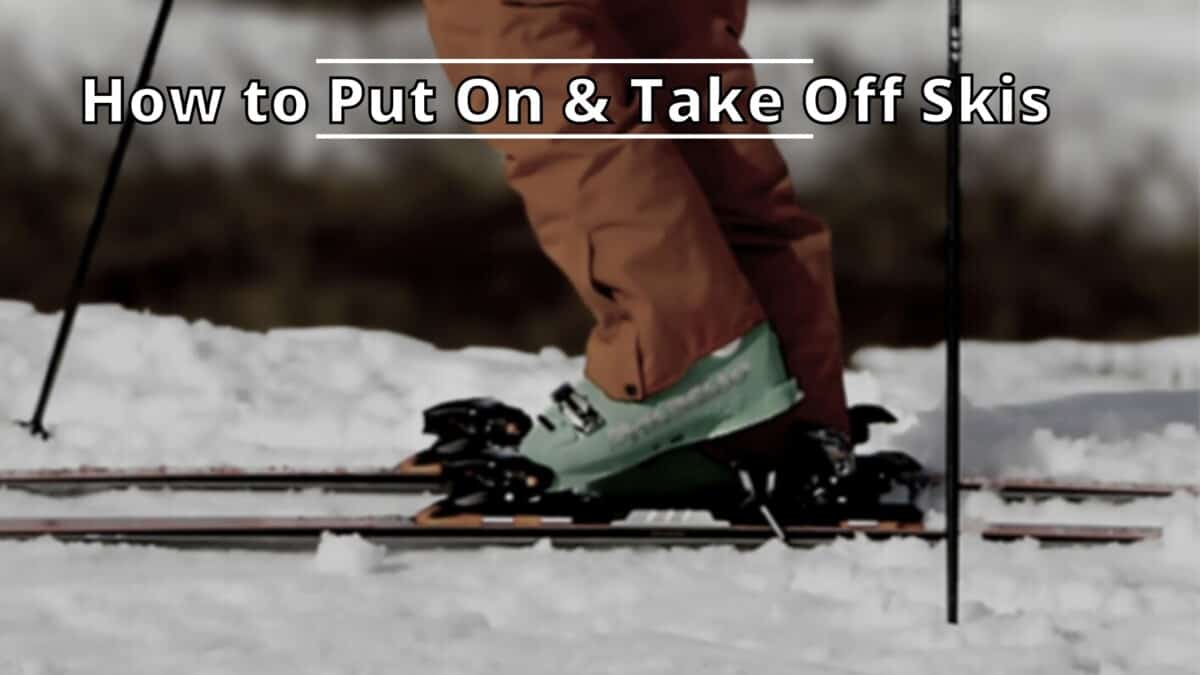Putting on skis and taking them off can be very frustrating, especially for beginners. Learning how to manage and put on all your ski equipment takes time, and there are some basic rules to be followed so that everything will be much easier.
To put your skis on, lay them down across the slope, so that the skis won’t start sliding. Make sure that the ski bindings’ heel pieces are pushed down, use your ski poles to remove excess snow from your boots or gently tap your boots against the binding to remove the snow, always use your ski poles to keep you balanced.
To take them off, make sure that you’re in a steady position, and use your ski poles to press down the heel lever on the back of the bindings, and take off the weight from your heel.
Remember that your boots and bindings establish a direct connection to transfer your body movement to the skis, so it is important that they are set properly and taken off with care. Read our guide below for more information on how you can get in and out of your skis.
Owning your own ski gear will save you money in the long run and will make your time on the mountain worthwhile and all the more delightful. There are plenty of them out on the market, and our list of the best all-mountain skis of 2022 will help you narrow down your options.
Before putting on skis
Make sure that the skis won’t slide. They need to be laid down across the slope as you put them on, so that you will be standing sideways and won’t slide anywhere.
Make sure that there is no snow stuck under your ski boot because too much snow will prevent the binding from closing properly. If there’s any snow stuck under, scape it off using your poles. If the snow is too hard to be scraped off, you should bang or stomp the back of the boots against the binding as carefully as possible.
Use your poles to keep your balance while you are booting up, so that it is easier to stand on one leg on a slippery surface.
Putting on ski boots
- Unfasten the boots buckles and the power strap at the top.
- Open the boot by grabbing the loop of the tongue, then pull it forward (away from you) and off to the side.
- Stand up, then step into the boot by sliding your toes in first, and then your heel. Get your foot in at the correct angle by bending your knees and flexing your shins forward.
- Hold the tongue loop and pull up on everything. The tongue should be centered and the buckle flaps should overlap properly.
- Stand up with your heel on the ground and your toe pointed up at an approximate 45-degree angle from the ground.
- Fasten the power strap, but don’t secure it as tight yet.
- Start buckling the top of the boot all the way down.
- Fasten the top buckles. It should require some effort to close the buckles and get a nice, firm snap. The second buckle from the top is for keeping your heel in place and it is the most important to secure.
- Secure your power strap, so that it is as snug as the top buckles.
- Flex forward and then fasten the boot’s lower buckles.
Putting on skis
- Lay the skis on a flat surface or across the slope, at a 90-degree angle to the fall line, so that they don’t slide away. It is best to put your skis on close to where you want to start skiing.
- There is usually no designated right or left foot on skis. But sometimes, ski technicians mount and test bindings using a left or right boot and might mark skis right or left.
- Make sure that the ski bindings’ heel pieces are pushed down.
- Use your ski poles to remove excess snow from your boots or gently tap your boots against the binding to remove the snow. Also, clear the snow on the binding toe piece.
- Use your poles for balance. You’ll want to put on your downhill ski first if you’re on a hill to give you more stability before clicking into the second ski.
- Align the toe of your boot with the ski binding’s toe piece. Note that if the ski brake sits under your heel, then your skis are facing the correct direction.
- Look back at your heel piece by standing on your tiptoe and drop your heel down into the binding until you hear a solid click. The heel piece should now be flipped up and your boot should be secured to your ski.
Common mistakes
- Not properly laying down the skis across the slope.
- Putting the uphill ski on first instead of the downhill ski.
- Forgetting to clear the snow from the sole of the boot.
Once you have successfully put on your ski boots and skis, it’s time to slide down the slopes and enjoy skiing. If you’re a first time skier, we have a guide on learning how to ski as a beginner that is filled with tips and tricks to help you get started.
Taking boots off
- Undo all of the buckles, starting from the toe and up to the top buckle.
- Pull the boot’s tongue forward and off to the side to be able to open the boot up. Then grasp the back of the boot and push it away as you pull your foot out.
Taking skis off
- Find a moderately flat spot and make sure that you are in a steady position.
- Use your ski pole to push down the heel lever on the back of the binding, while you take your weight off of the heel.
- The heel piece will then rotate upwards and release the heel of the ski boot.
- Make sure to push down firmly to be able to release your boot from the binding.
- Lift your foot to the side, and then step out. Then, repeat the process with the other ski.
It is not important which ski you take off first, but it is usually easier to remove the uphill ski before taking the downhill ski off.
Common mistakes
- Some skiers may disregard taking their weight off of the heel when taking off their skis. But, it is important to do that to be able to release the boot.
- Some may also forget to set themselves up properly before taking their skis off.
Conclusion
Putting on and taking off your skis is not an easy process and it can be especially challenging for those who are just starting with the sport. In order to properly and easily wear and take off your skis, you need to be familiar with your skiing equipment, specifically your skis, bindings, and boots.
If you want to get better at wearing and taking off your skis, all you have to do is practice as much as you can until you master this process. It’s also important that you remember to always ask a professional for guidance to avoid any mistakes while you are putting on or taking off your skis on the slope.

